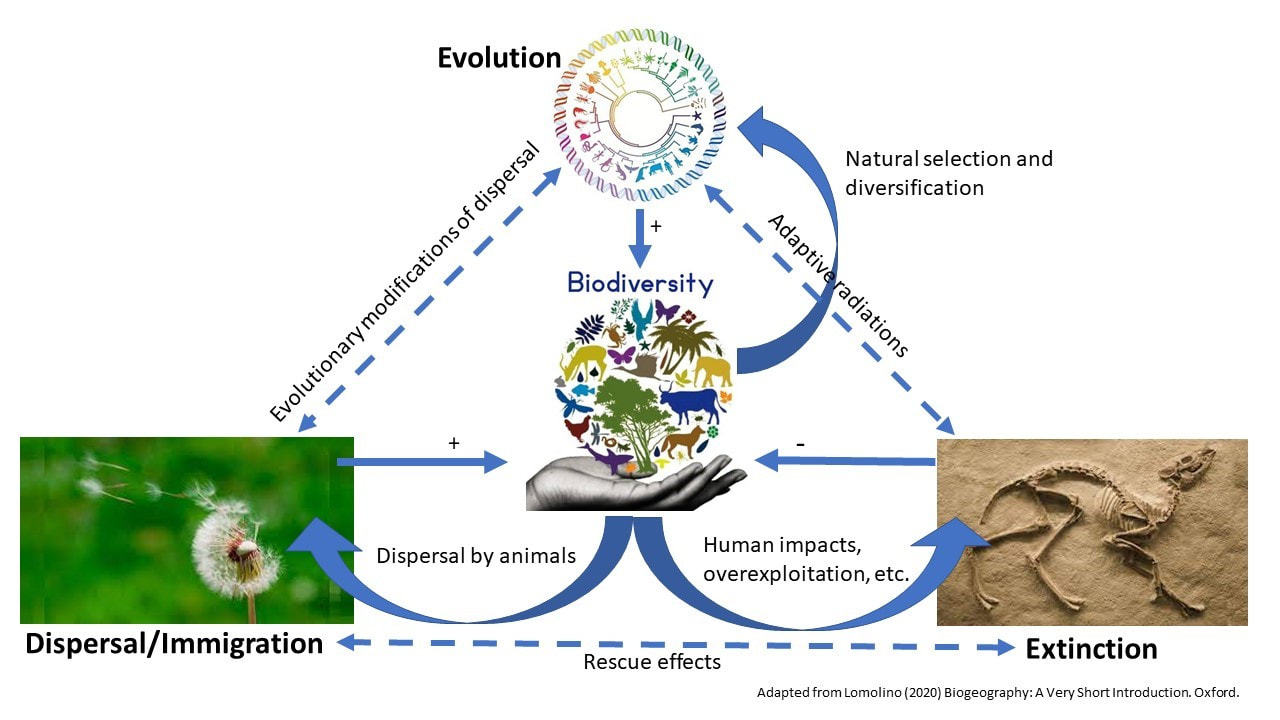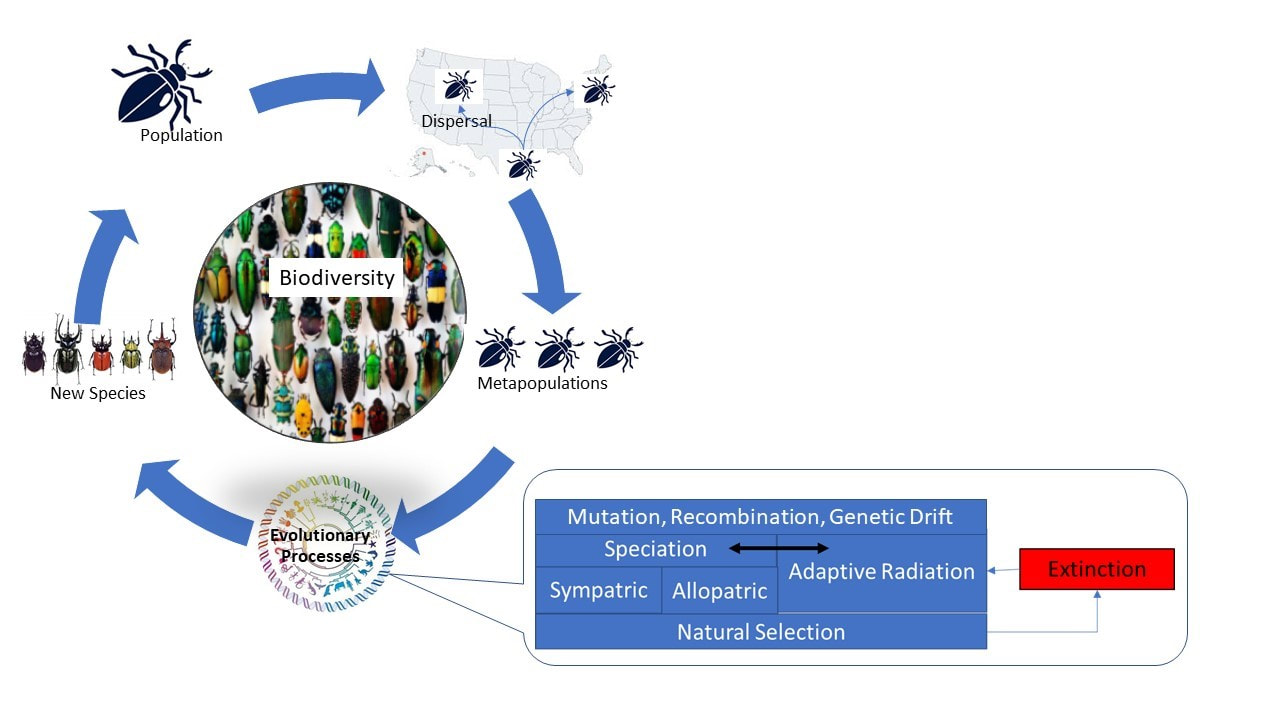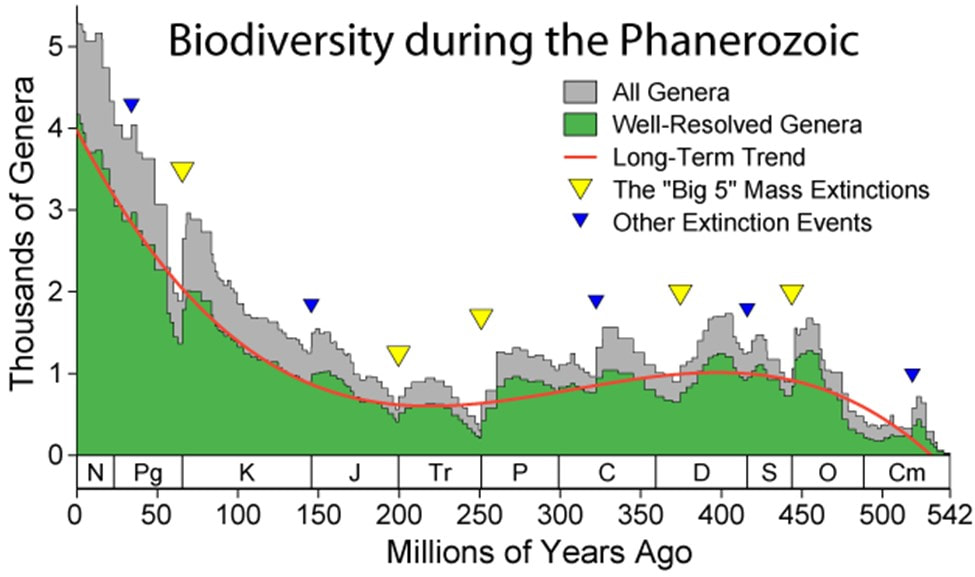|
We live in fast paced times where the human definition of long term is often next month. But the ecological and evolutionary processes driving biodiversity play out over periods ranging from decades to millennia. Part 1 of this series discussed the what of biodiversity – what it is and the challenges in defining and measuring it. In Part 2, we’ll discuss how of biodiversity – how it emerged and how it has changed over past millennia. How did biodiversity come into existence? What drives it? Biodiversity – the variety of life on this planet – is not constant or static. It is always changing – contracting, expanding, moving, changing. Three fundamental processes – evolution, dispersal, and extinction – drive life’s variety (Figure 1).[1] But these processes operate over long periods of time to shape the species and ecosystems we see today. Understanding the long view of biodiversity, therefore, is important for our understanding of current patterns and trends around us. Evolution, extinction, and dispersal are inter-related and subject to various ecological feedbacks and species interactions, especially human interactions (Figure 1). Chance and historical contingency also play a role through random events affecting evolution’s fundamental mechanisms of mutation, genetic recombination, and genetic drift. Let’s start with dispersal. Figure 1 Dispersal. Dispersal is a key ecological mechanism in response to competition between parent and offspring for limited resources. Dispersal allows for the colonization of new habitats with new resources. Patterns of dispersal depend on a variety of factors and combinations, such as temperature, precipitation, altitude, soils, geography, aspect, and other species. As the population of a species increases, it spreads out to exploit new habitats and food resources. This results in a number of separate populations in different habitats, so-called meta-populations. Even though they initially contain the same species, these meta-populations may be prevented from interbreeding because of geographic separation or physical barriers (allopatric populations) or differences in behavior, phenology, or other non-physical isolating factors (sympatric populations). Eventually, these separate populations may differ sufficiently from each other to trigger the evolutionary processes discussed next. Evolution. Evolution is the main engine behind biodiversity. Through the evolutionary process, as illustrated in Figure 2, new species arise, beginning with the dispersal of a species across a number of meta-populations as described above. Eventually, these meta-populations may diverge and form new species through the processes of adaptive radiation, speciation, and natural selection. Figure 2 Extinction. One may not think of extinction as a driver of biodiversity, but species extinctions often create opportunities in the form of open habitats and available resources that other existing or new species can take advantage of overtime. However, extinctions, particularly mass extinction events, can set off a complex and uncertain chain of events with a number of effects on evolutionary processes, ecosystem structure, and ecological functions (see Erwin, 2000). A certain level of extinction is a natural part of life; some species succeed and some fail to adjust to a changing environment. Background or “natural” extinction rates (i.e., rates existing before humans) are typically measured in units of extinctions per million species per year (E/MSY). Various estimates of the background extinction rate range from 0.1 to 2 extinctions per million species per year (Pimm, et al., 2014). In Part 3, we will see that estimates of current and projected extinction rates as influenced by humans are exceeding this background rate by orders of magnitude. How has biodiversity changed over time? Over millions of years biodiversity as waxed and waned, starting with rapid growth during the Cambrian explosion over 500 million years ago —a period during which nearly every phylum of multicellular organisms first appeared (Gould, 1989). Since the Cambrian, biodiversity has increased dramatically, albeit suffering periodic, mass extinction events (Figure 3). Five major mass extinction events and a number lesser extinction events have occurred over the last 500 million years (Box 1). Figure 3 The Big Five mass extinctions significantly exceeded the background extinction rate and were believed to be caused by natural events (since humans did not yet exist), such as natural shifts in the climate, volcanoes, meteors, habitat changes, competition, and atmospheric changes.
Following each of these events, the level of biodiversity took approximately 10-20 million years to recover to its pre-extinction event diversity levels. As we shall discuss in Part 3, a number of scientists argue strongly that we are currently in a sixth mass extinction event, driven not by natural causes but by human-induced ones. In Part 1 we noted the challenges with measuring biodiversity. Measuring biodiversity in the past faces its own measurement challenges. It critically depends on the fossil record and the ability of paleontologists to discovery and classify those fossils. As we know, the fossil record is fragmented and incomplete. Measures of biodiversity based on the fossil record are subject to sampling bias, how fossils are counted (by species, genera, family), and the “pull of the recent” (the better sampling of more recent species). But as more fossils are being discovered, and more sophisticated statistical techniques used, the general shape of the biodiversity curve over time remains similar to the one above. ______________________________________________________________________________________________________________________________ Box 1: The “Big Five” Mass Extinction Events
But scientists still retain a healthy skepticism as to the precision and accuracy of these measurements. What does this long view tell us about today’s patterns of biodiversity? Evolutionary forces in combination with the physical environment has established some general patterns with regards to biodiversity. First, biodiversity tends to increase from the poles to the equator. This is largely due to the greater productivity of ecosystems in line with more precipitation, increasing moderation in seasons, and increased solar radiation as you approach the equator. Second, biodiversity on land is thought to be up to 25 times greater than ocean biodiversity. On land, forests harbor most of Earth's biodiversity and within forest types, tropical rain forests are the most biologically diverse. In addition, the Earth’s terrestrial subsurface contains a substantial amount of biomass and diversity (McMahon and Parnell, 2018). Finally, a general principle of ecology is that the larger the area the more species it contains – known as the species-area relationship. This relationship is largely a factor of a greater range of resources, abiotic heterogeneity, and varied landscape for species to colonize and form communities. The history of biodiversity also reveals that mass extinction events typically have long recovery periods, as well as restructure and reorder ecosystems and species composition in different and unexpected ways. Key Takeaways for Master Naturalists Why should a Master Naturalist, striving to earn volunteer hours, be concerned with changes in biodiversity over past millennia? Four reasons come to mind – the four C’s. First, curiosity which is an essential ingredient of a Master Naturalist. We simply want to learn more about nature and the world around us, and a perennial question when we look around us is ‘how did this all come about?’. Second, context. Part of being a Master Naturalist is observing, identifying, and noting patterns in the species and habitats around us. Knowing the history of the environment around us allows us to put what we are observing today into a larger context. Studying the long-run patterns and drivers of biodiversity provides a history lesson in species interactions, ecological feedbacks, environmental pressures, and evolutionary processes that shape today’s patterns of life. In the words of Michael Crichton, “If you don’t know history, then you don’t know anything. You are a leaf that doesn’t know it is part of a tree.” Third, cause and effect. Understanding the cause -- how biodiversity emerged through processes such as evolution, extinction, and dispersal -- helps us to understand the effect -- current patterns, ongoing trends, and future likelihoods. So, ask yourself:
Finally, contribution. Understanding the trends and drivers of long-term biodiversity patterns provides a foundation and motivation for our various contributions as Master Naturalists in the areas of conservation, restoration, and stewardship activities, as well as our citizen science efforts. It provides the “bigger picture” that allows us to see how our efforts fit into something larger than ourselves and our immediate times. In the next installment (Part 3), we will discuss the current and future state of biodiversity and some critical, and worrisome, trends unfolding around us. ------------------------ [1] The processes of evolution, dispersal, and extinction are not entirely deterministic, but rather subject to historical contingency, so chance plays a role in the biodiversity we see around us. Historical processes, such as evolution, display some degree of “contingency,” meaning their outcomes are sensitive to seemingly inconsequential events that can fundamentally change the future. Contingency is what makes historical outcomes unpredictable. For example, “evolutionary outcomes may depend on idiosyncratic events that an evolving lineage experiences— such as the order of appearance of random mutations or rare environmental perturbations— making evolutionary outcomes unrepeatable” (Blount, Lenski, and Losos, 2018). ------------------------ Further Reading The Sixth Extinction, by Elizabeth Kolbert (2014, Picador Publishing) Wonderful Life: The Burgess Shale and the Nature of History, by Stephen Jay Gould (1989, Norton) Evolution: The Triumph of an Idea, by Carl Zimmer (2006, Harper Collins) References Barnosky, et al. (2011). Has the Earth’s sixth mass extinction already arrived? Nature 471 doi:10.1038/nature09678 Blount, Z.D., Lenski, R.E., and Losos, J.B. (2018). Contingency and determinism in evolution: Replaying life’s tape, Science 362: 655. Erwin, Douglas H. (2000). Lessons from the Past: Biotic Recoveries from Mass Extinctions. Santa Fe Institute Working Paper: 2000-12-067 Locey and Lennon (2016). Scaling laws predict global microbial diversity. PNAS, 113(21): 5970–5975 www.pnas.org/cgi/doi/10.1073/pnas.1521291113 McMahon, S. and John Parnell (2018). The deep history of Earth’s biomass. Journal of the Geological Society, 175: 716-720, https://doi.org/10.1144/jgs2018-061 Mora, C.; et al. (2011). "How Many Species Are There on Earth and in the Ocean?". PLOS Biology. 9 (8): e1001127. doi:10.1371/journal.pbio.1001127 Pimm, S.L., et al., (2014). The biodiversity of species and their rates of extinction, distribution, and protection. Science 344 (6187), 1246752. DOI: 10.1126/science.1246752.
0 Comments
Your comment will be posted after it is approved.
Leave a Reply. |
Have a blog or blog idea?
Let us know (click) Other Blogs
VA Native Plant Society - click Brenda Clement Jones - click John Muir Laws' Blog - click Megan's Nature Nook - click Categories
All
Archives
September 2023
Blog Administrator:
Kathleen A. VMN since 2018 |


